Cloud Computing for MetaSoft: Office Automation, Migration to IaaS or PaaS, and Cloud Models
VerifiedAdded on 2023/06/08
|18
|2855
|91
AI Summary
This report discusses the implementation of cloud computing for MetaSoft, including office automation, migration to IaaS or PaaS, and cloud models. The report covers the benefits and issues of different approaches and models, and provides recommendations for MetaSoft.
Contribute Materials
Your contribution can guide someone’s learning journey. Share your
documents today.
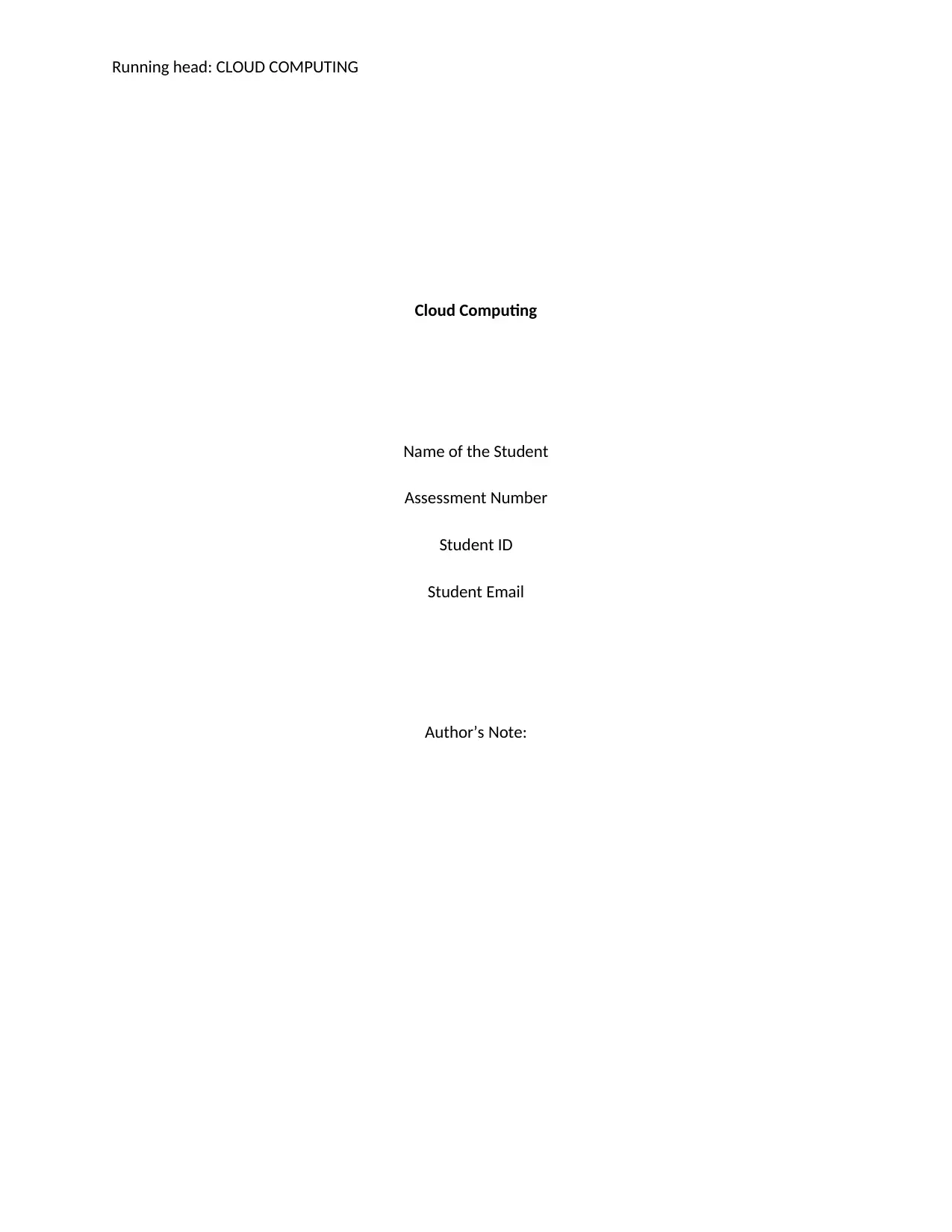
Running head: CLOUD COMPUTING
Cloud Computing
Name of the Student
Assessment Number
Student ID
Student Email
Author’s Note:
Cloud Computing
Name of the Student
Assessment Number
Student ID
Student Email
Author’s Note:
Secure Best Marks with AI Grader
Need help grading? Try our AI Grader for instant feedback on your assignments.
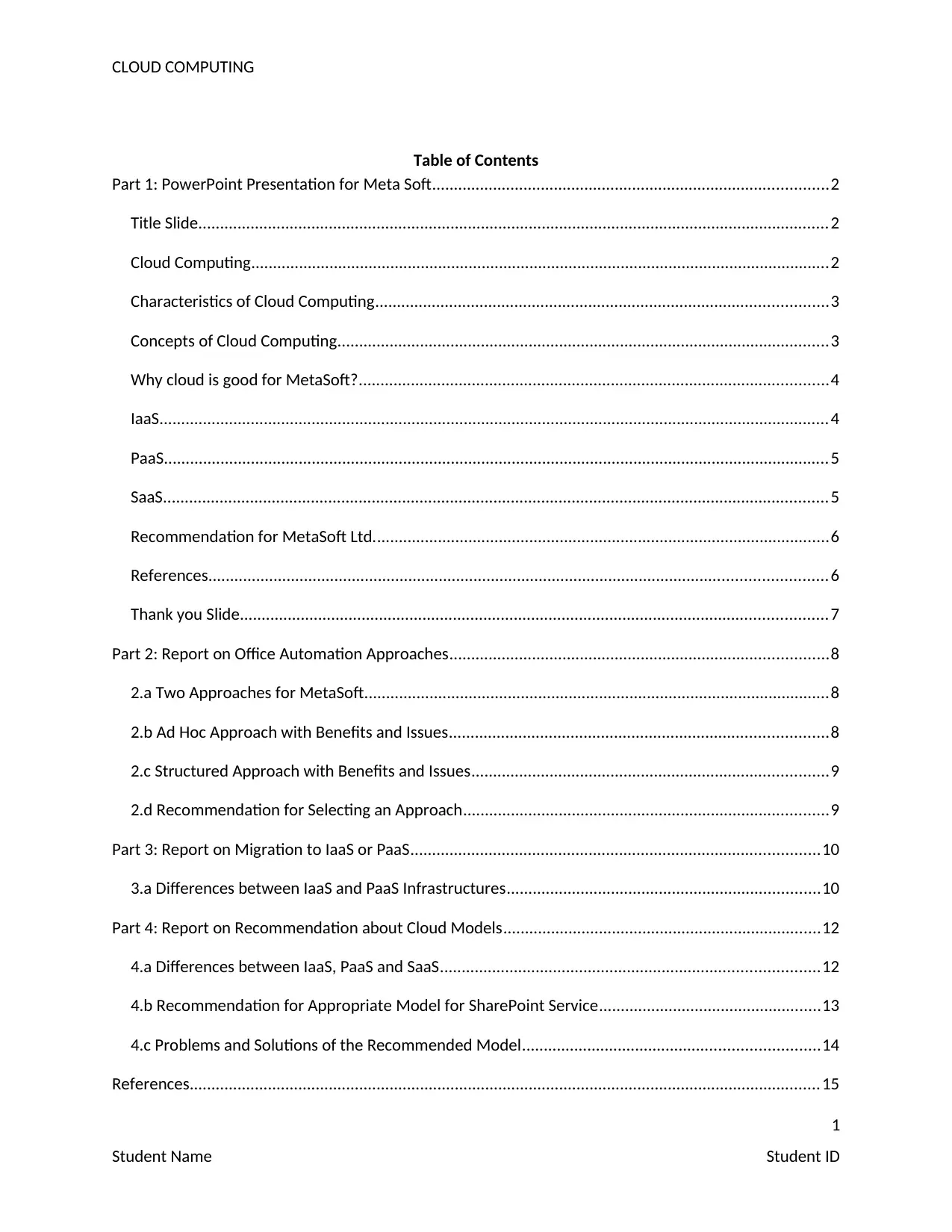
CLOUD COMPUTING
Table of Contents
Part 1: PowerPoint Presentation for Meta Soft...........................................................................................2
Title Slide.................................................................................................................................................2
Cloud Computing.....................................................................................................................................2
Characteristics of Cloud Computing........................................................................................................3
Concepts of Cloud Computing.................................................................................................................3
Why cloud is good for MetaSoft?............................................................................................................4
IaaS..........................................................................................................................................................4
PaaS.........................................................................................................................................................5
SaaS.........................................................................................................................................................5
Recommendation for MetaSoft Ltd.........................................................................................................6
References..............................................................................................................................................6
Thank you Slide.......................................................................................................................................7
Part 2: Report on Office Automation Approaches.......................................................................................8
2.a Two Approaches for MetaSoft...........................................................................................................8
2.b Ad Hoc Approach with Benefits and Issues.......................................................................................8
2.c Structured Approach with Benefits and Issues..................................................................................9
2.d Recommendation for Selecting an Approach....................................................................................9
Part 3: Report on Migration to IaaS or PaaS..............................................................................................10
3.a Differences between IaaS and PaaS Infrastructures........................................................................10
Part 4: Report on Recommendation about Cloud Models.........................................................................12
4.a Differences between IaaS, PaaS and SaaS.......................................................................................12
4.b Recommendation for Appropriate Model for SharePoint Service...................................................13
4.c Problems and Solutions of the Recommended Model....................................................................14
References.................................................................................................................................................15
1
Student Name Student ID
Table of Contents
Part 1: PowerPoint Presentation for Meta Soft...........................................................................................2
Title Slide.................................................................................................................................................2
Cloud Computing.....................................................................................................................................2
Characteristics of Cloud Computing........................................................................................................3
Concepts of Cloud Computing.................................................................................................................3
Why cloud is good for MetaSoft?............................................................................................................4
IaaS..........................................................................................................................................................4
PaaS.........................................................................................................................................................5
SaaS.........................................................................................................................................................5
Recommendation for MetaSoft Ltd.........................................................................................................6
References..............................................................................................................................................6
Thank you Slide.......................................................................................................................................7
Part 2: Report on Office Automation Approaches.......................................................................................8
2.a Two Approaches for MetaSoft...........................................................................................................8
2.b Ad Hoc Approach with Benefits and Issues.......................................................................................8
2.c Structured Approach with Benefits and Issues..................................................................................9
2.d Recommendation for Selecting an Approach....................................................................................9
Part 3: Report on Migration to IaaS or PaaS..............................................................................................10
3.a Differences between IaaS and PaaS Infrastructures........................................................................10
Part 4: Report on Recommendation about Cloud Models.........................................................................12
4.a Differences between IaaS, PaaS and SaaS.......................................................................................12
4.b Recommendation for Appropriate Model for SharePoint Service...................................................13
4.c Problems and Solutions of the Recommended Model....................................................................14
References.................................................................................................................................................15
1
Student Name Student ID

CLOUD COMPUTING
2
Student Name Student ID
2
Student Name Student ID
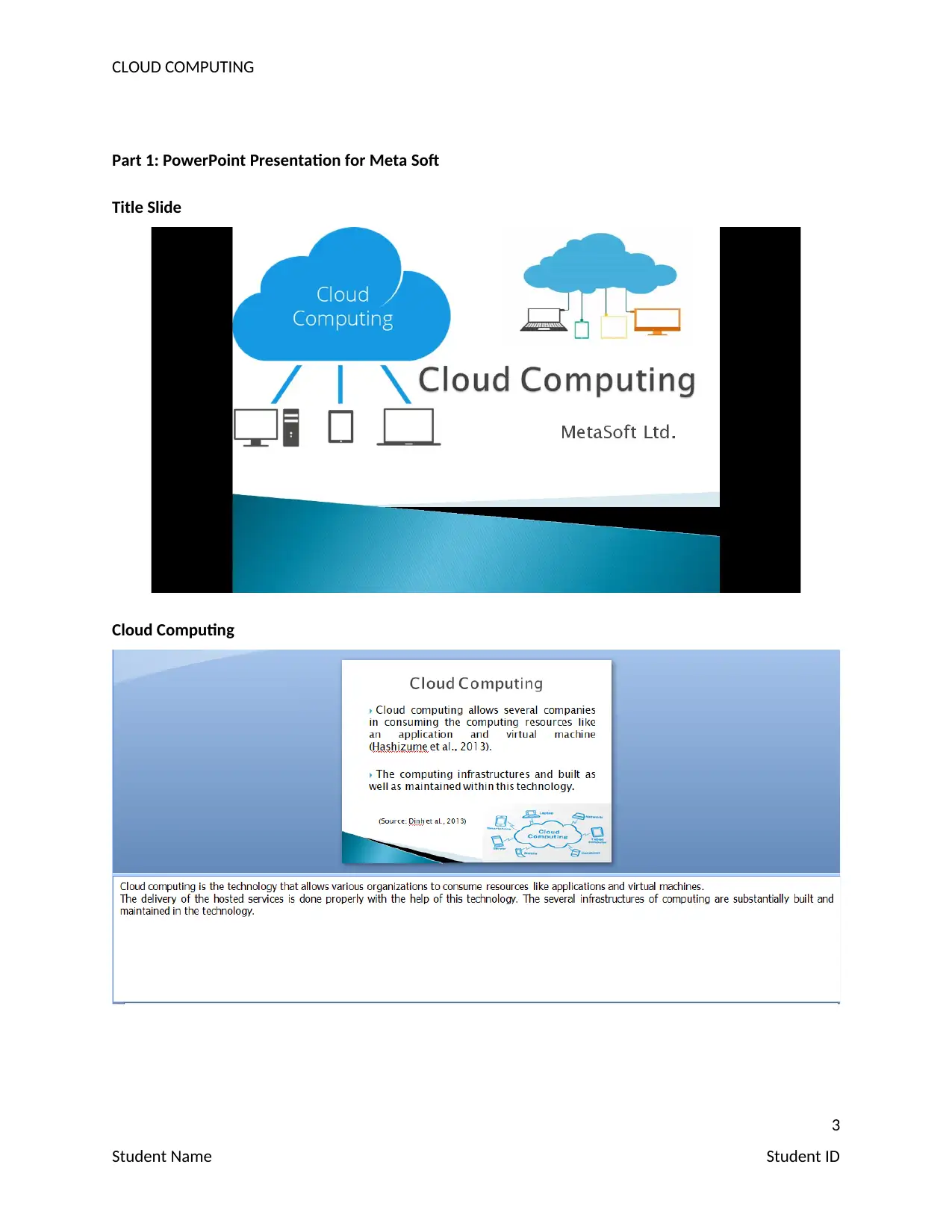
CLOUD COMPUTING
Part 1: PowerPoint Presentation for Meta Soft
Title Slide
Cloud Computing
3
Student Name Student ID
Part 1: PowerPoint Presentation for Meta Soft
Title Slide
Cloud Computing
3
Student Name Student ID
Secure Best Marks with AI Grader
Need help grading? Try our AI Grader for instant feedback on your assignments.
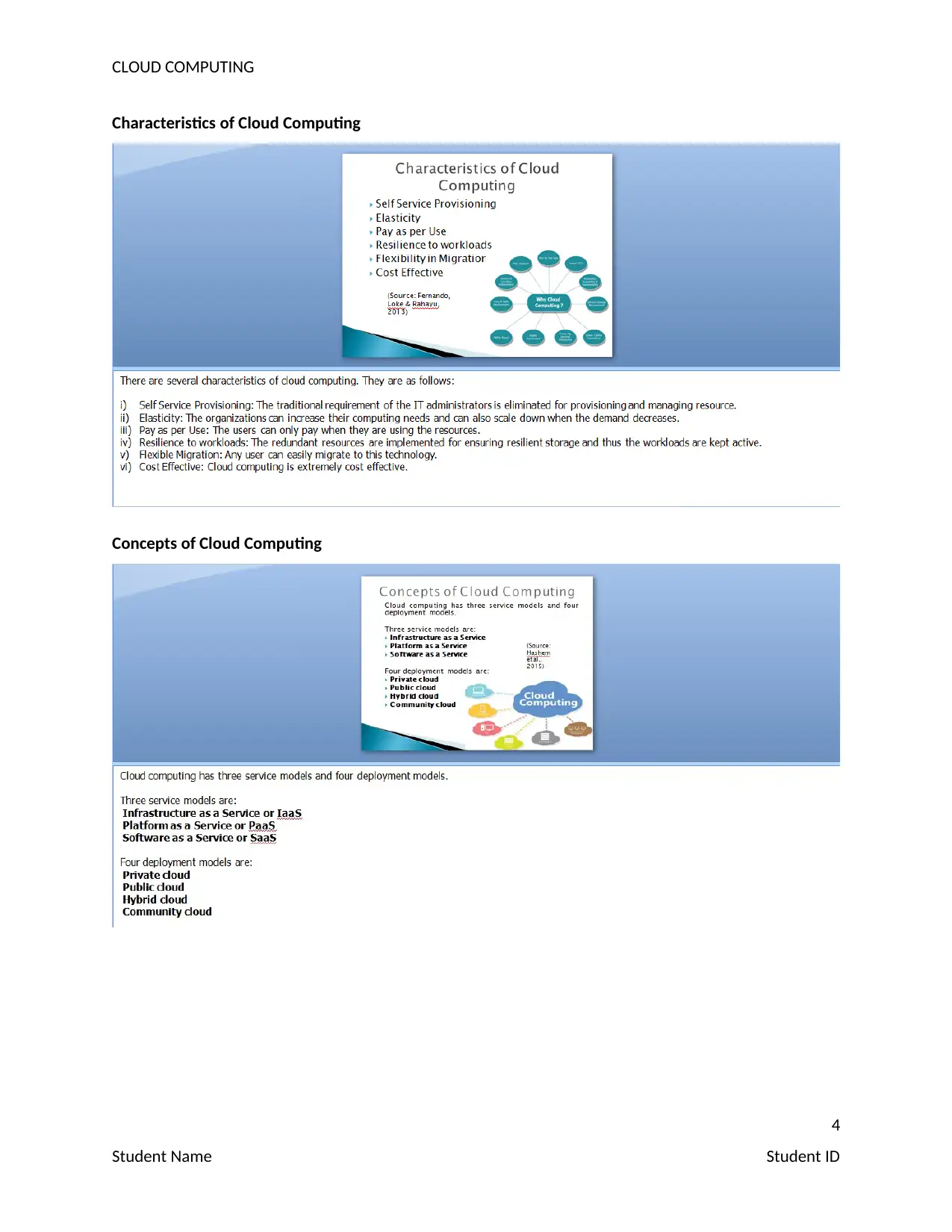
CLOUD COMPUTING
Characteristics of Cloud Computing
Concepts of Cloud Computing
4
Student Name Student ID
Characteristics of Cloud Computing
Concepts of Cloud Computing
4
Student Name Student ID

CLOUD COMPUTING
Why cloud is good for MetaSoft?
IaaS
5
Student Name Student ID
Why cloud is good for MetaSoft?
IaaS
5
Student Name Student ID
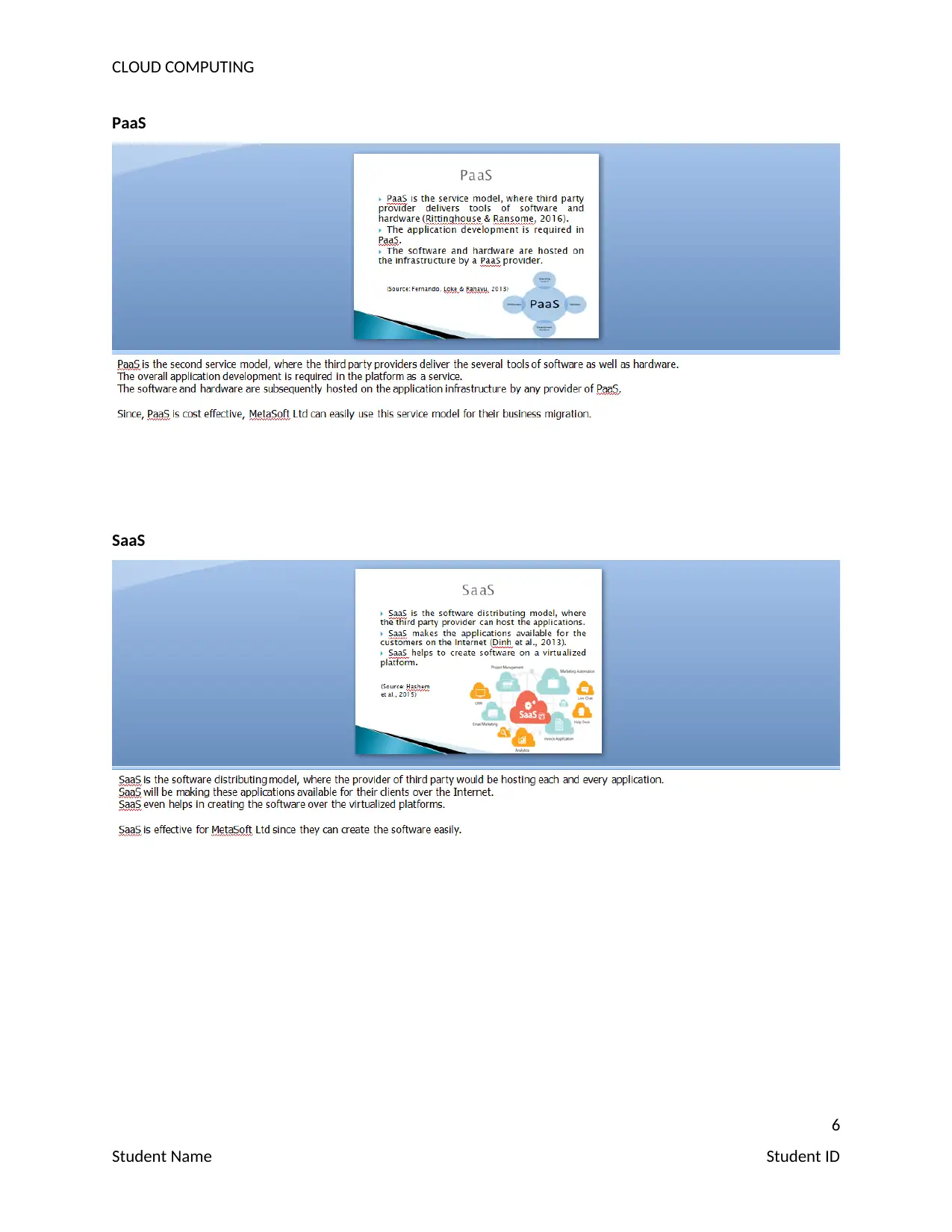
CLOUD COMPUTING
PaaS
SaaS
6
Student Name Student ID
PaaS
SaaS
6
Student Name Student ID
Paraphrase This Document
Need a fresh take? Get an instant paraphrase of this document with our AI Paraphraser
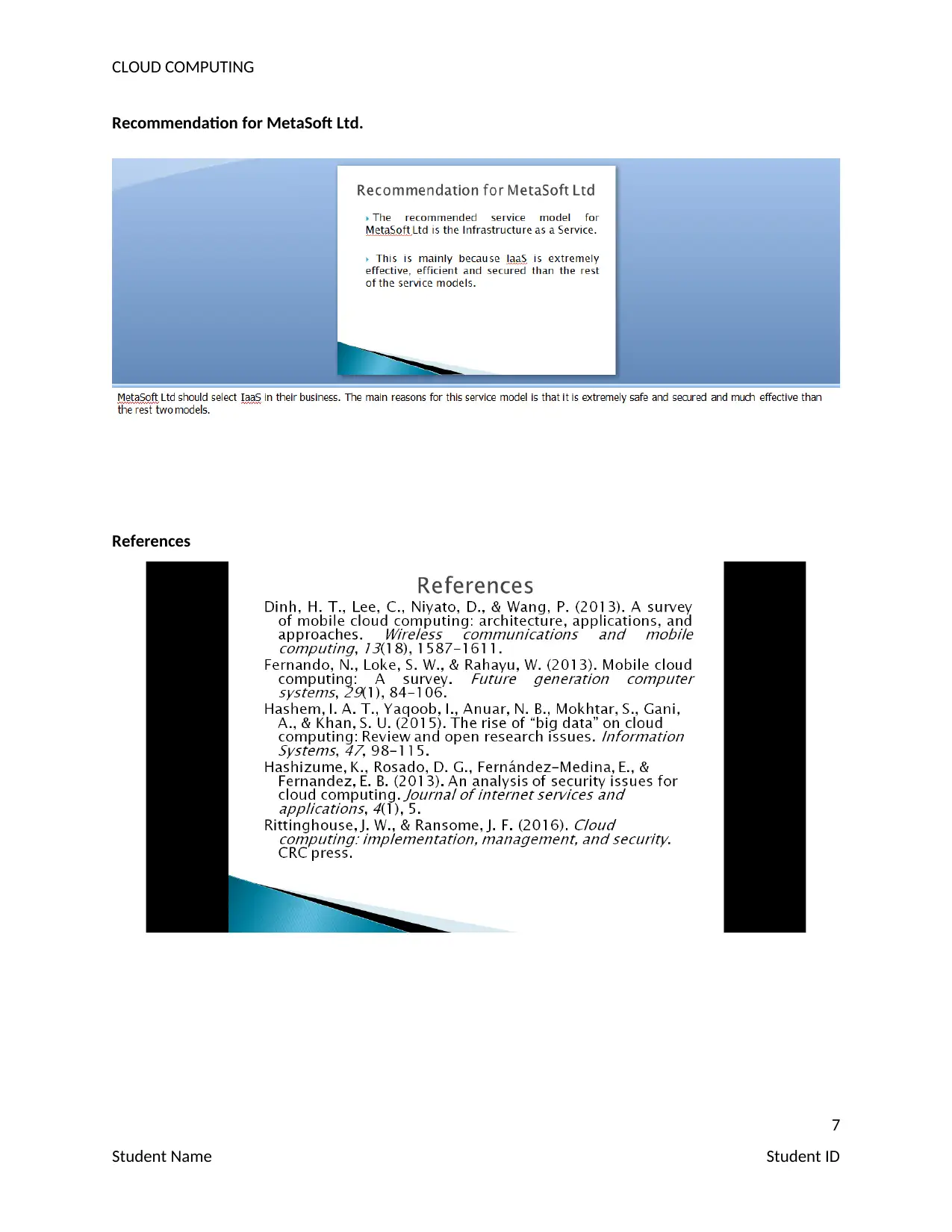
CLOUD COMPUTING
Recommendation for MetaSoft Ltd.
References
7
Student Name Student ID
Recommendation for MetaSoft Ltd.
References
7
Student Name Student ID
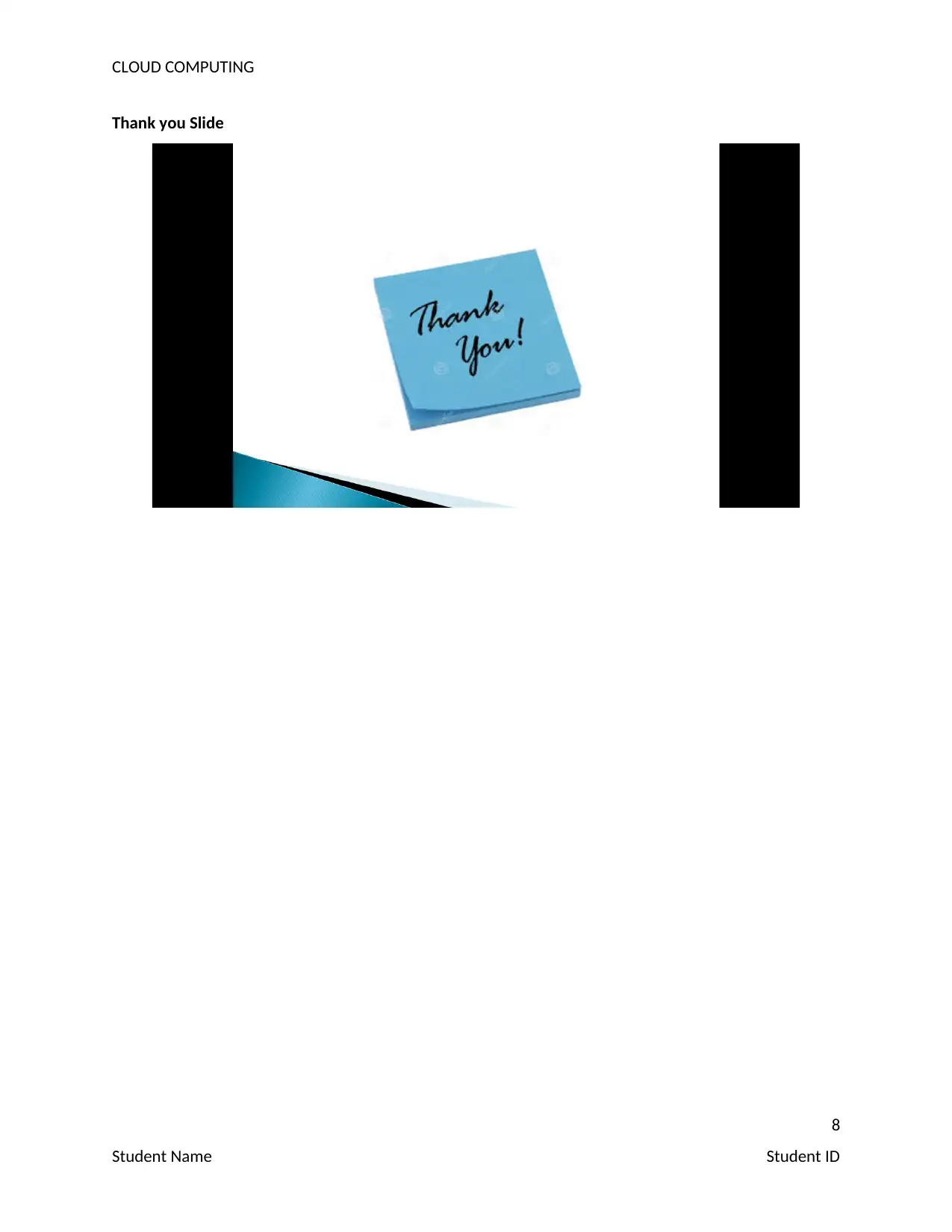
CLOUD COMPUTING
Thank you Slide
8
Student Name Student ID
Thank you Slide
8
Student Name Student ID
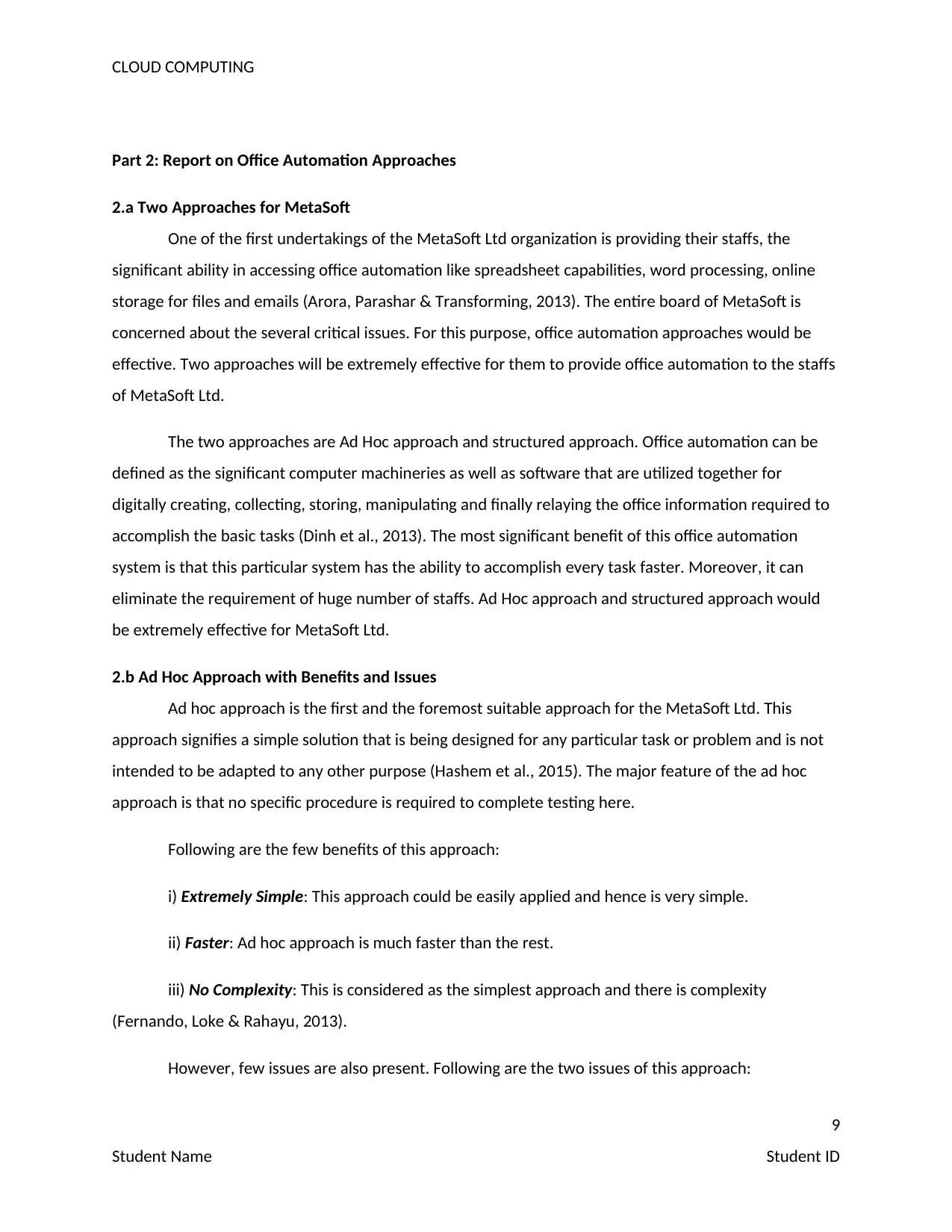
CLOUD COMPUTING
Part 2: Report on Office Automation Approaches
2.a Two Approaches for MetaSoft
One of the first undertakings of the MetaSoft Ltd organization is providing their staffs, the
significant ability in accessing office automation like spreadsheet capabilities, word processing, online
storage for files and emails (Arora, Parashar & Transforming, 2013). The entire board of MetaSoft is
concerned about the several critical issues. For this purpose, office automation approaches would be
effective. Two approaches will be extremely effective for them to provide office automation to the staffs
of MetaSoft Ltd.
The two approaches are Ad Hoc approach and structured approach. Office automation can be
defined as the significant computer machineries as well as software that are utilized together for
digitally creating, collecting, storing, manipulating and finally relaying the office information required to
accomplish the basic tasks (Dinh et al., 2013). The most significant benefit of this office automation
system is that this particular system has the ability to accomplish every task faster. Moreover, it can
eliminate the requirement of huge number of staffs. Ad Hoc approach and structured approach would
be extremely effective for MetaSoft Ltd.
2.b Ad Hoc Approach with Benefits and Issues
Ad hoc approach is the first and the foremost suitable approach for the MetaSoft Ltd. This
approach signifies a simple solution that is being designed for any particular task or problem and is not
intended to be adapted to any other purpose (Hashem et al., 2015). The major feature of the ad hoc
approach is that no specific procedure is required to complete testing here.
Following are the few benefits of this approach:
i) Extremely Simple: This approach could be easily applied and hence is very simple.
ii) Faster: Ad hoc approach is much faster than the rest.
iii) No Complexity: This is considered as the simplest approach and there is complexity
(Fernando, Loke & Rahayu, 2013).
However, few issues are also present. Following are the two issues of this approach:
9
Student Name Student ID
Part 2: Report on Office Automation Approaches
2.a Two Approaches for MetaSoft
One of the first undertakings of the MetaSoft Ltd organization is providing their staffs, the
significant ability in accessing office automation like spreadsheet capabilities, word processing, online
storage for files and emails (Arora, Parashar & Transforming, 2013). The entire board of MetaSoft is
concerned about the several critical issues. For this purpose, office automation approaches would be
effective. Two approaches will be extremely effective for them to provide office automation to the staffs
of MetaSoft Ltd.
The two approaches are Ad Hoc approach and structured approach. Office automation can be
defined as the significant computer machineries as well as software that are utilized together for
digitally creating, collecting, storing, manipulating and finally relaying the office information required to
accomplish the basic tasks (Dinh et al., 2013). The most significant benefit of this office automation
system is that this particular system has the ability to accomplish every task faster. Moreover, it can
eliminate the requirement of huge number of staffs. Ad Hoc approach and structured approach would
be extremely effective for MetaSoft Ltd.
2.b Ad Hoc Approach with Benefits and Issues
Ad hoc approach is the first and the foremost suitable approach for the MetaSoft Ltd. This
approach signifies a simple solution that is being designed for any particular task or problem and is not
intended to be adapted to any other purpose (Hashem et al., 2015). The major feature of the ad hoc
approach is that no specific procedure is required to complete testing here.
Following are the few benefits of this approach:
i) Extremely Simple: This approach could be easily applied and hence is very simple.
ii) Faster: Ad hoc approach is much faster than the rest.
iii) No Complexity: This is considered as the simplest approach and there is complexity
(Fernando, Loke & Rahayu, 2013).
However, few issues are also present. Following are the two issues of this approach:
9
Student Name Student ID
Secure Best Marks with AI Grader
Need help grading? Try our AI Grader for instant feedback on your assignments.
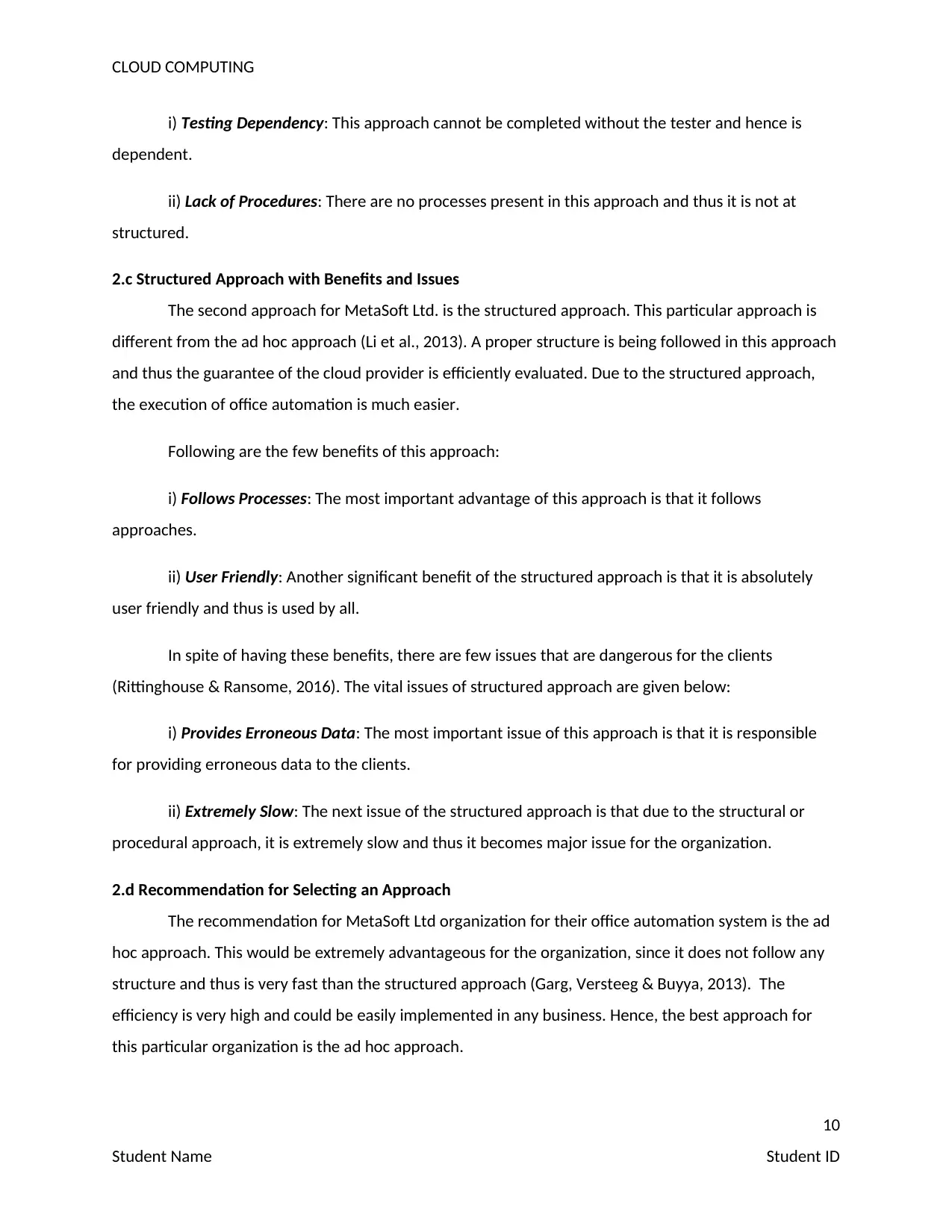
CLOUD COMPUTING
i) Testing Dependency: This approach cannot be completed without the tester and hence is
dependent.
ii) Lack of Procedures: There are no processes present in this approach and thus it is not at
structured.
2.c Structured Approach with Benefits and Issues
The second approach for MetaSoft Ltd. is the structured approach. This particular approach is
different from the ad hoc approach (Li et al., 2013). A proper structure is being followed in this approach
and thus the guarantee of the cloud provider is efficiently evaluated. Due to the structured approach,
the execution of office automation is much easier.
Following are the few benefits of this approach:
i) Follows Processes: The most important advantage of this approach is that it follows
approaches.
ii) User Friendly: Another significant benefit of the structured approach is that it is absolutely
user friendly and thus is used by all.
In spite of having these benefits, there are few issues that are dangerous for the clients
(Rittinghouse & Ransome, 2016). The vital issues of structured approach are given below:
i) Provides Erroneous Data: The most important issue of this approach is that it is responsible
for providing erroneous data to the clients.
ii) Extremely Slow: The next issue of the structured approach is that due to the structural or
procedural approach, it is extremely slow and thus it becomes major issue for the organization.
2.d Recommendation for Selecting an Approach
The recommendation for MetaSoft Ltd organization for their office automation system is the ad
hoc approach. This would be extremely advantageous for the organization, since it does not follow any
structure and thus is very fast than the structured approach (Garg, Versteeg & Buyya, 2013). The
efficiency is very high and could be easily implemented in any business. Hence, the best approach for
this particular organization is the ad hoc approach.
10
Student Name Student ID
i) Testing Dependency: This approach cannot be completed without the tester and hence is
dependent.
ii) Lack of Procedures: There are no processes present in this approach and thus it is not at
structured.
2.c Structured Approach with Benefits and Issues
The second approach for MetaSoft Ltd. is the structured approach. This particular approach is
different from the ad hoc approach (Li et al., 2013). A proper structure is being followed in this approach
and thus the guarantee of the cloud provider is efficiently evaluated. Due to the structured approach,
the execution of office automation is much easier.
Following are the few benefits of this approach:
i) Follows Processes: The most important advantage of this approach is that it follows
approaches.
ii) User Friendly: Another significant benefit of the structured approach is that it is absolutely
user friendly and thus is used by all.
In spite of having these benefits, there are few issues that are dangerous for the clients
(Rittinghouse & Ransome, 2016). The vital issues of structured approach are given below:
i) Provides Erroneous Data: The most important issue of this approach is that it is responsible
for providing erroneous data to the clients.
ii) Extremely Slow: The next issue of the structured approach is that due to the structural or
procedural approach, it is extremely slow and thus it becomes major issue for the organization.
2.d Recommendation for Selecting an Approach
The recommendation for MetaSoft Ltd organization for their office automation system is the ad
hoc approach. This would be extremely advantageous for the organization, since it does not follow any
structure and thus is very fast than the structured approach (Garg, Versteeg & Buyya, 2013). The
efficiency is very high and could be easily implemented in any business. Hence, the best approach for
this particular organization is the ad hoc approach.
10
Student Name Student ID
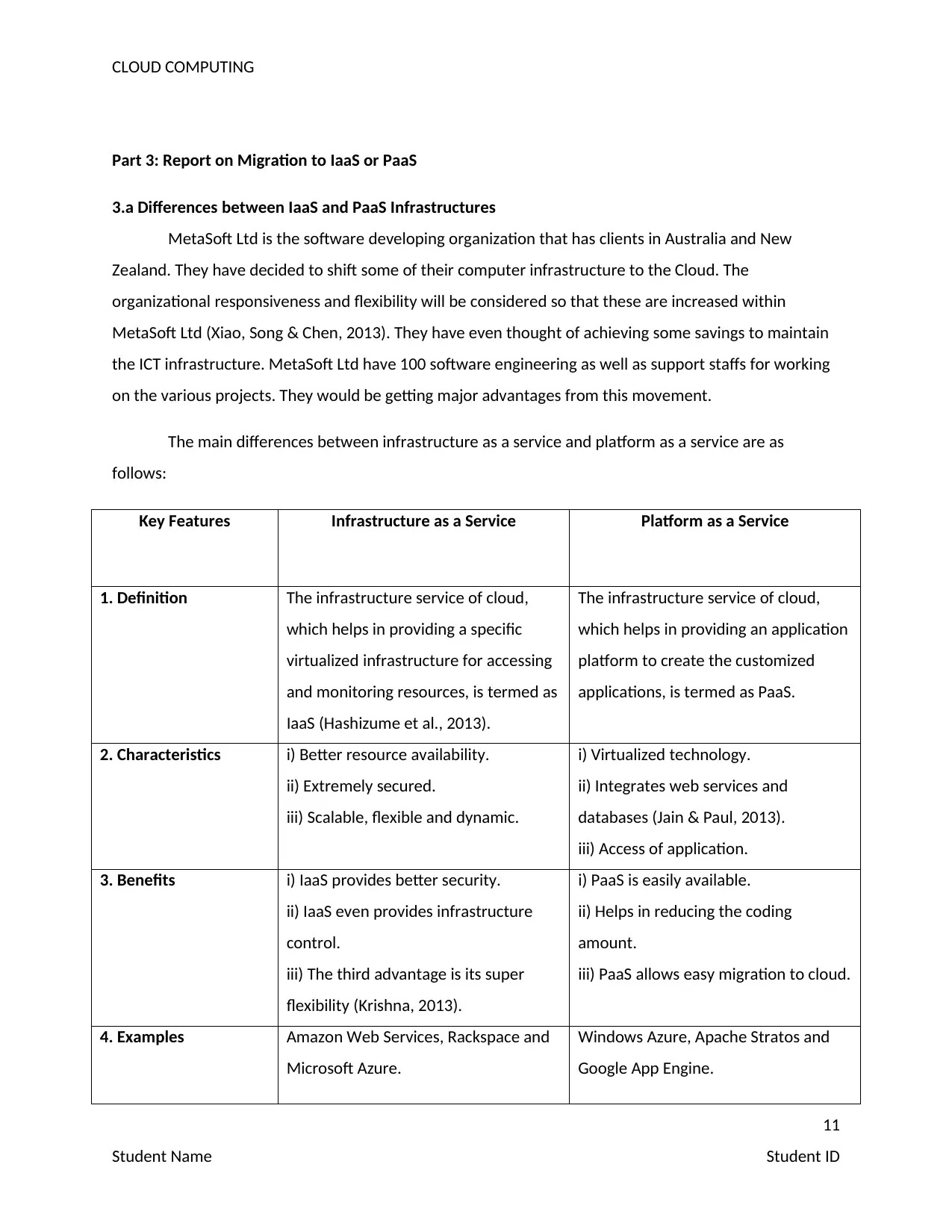
CLOUD COMPUTING
Part 3: Report on Migration to IaaS or PaaS
3.a Differences between IaaS and PaaS Infrastructures
MetaSoft Ltd is the software developing organization that has clients in Australia and New
Zealand. They have decided to shift some of their computer infrastructure to the Cloud. The
organizational responsiveness and flexibility will be considered so that these are increased within
MetaSoft Ltd (Xiao, Song & Chen, 2013). They have even thought of achieving some savings to maintain
the ICT infrastructure. MetaSoft Ltd have 100 software engineering as well as support staffs for working
on the various projects. They would be getting major advantages from this movement.
The main differences between infrastructure as a service and platform as a service are as
follows:
Key Features Infrastructure as a Service Platform as a Service
1. Definition The infrastructure service of cloud,
which helps in providing a specific
virtualized infrastructure for accessing
and monitoring resources, is termed as
IaaS (Hashizume et al., 2013).
The infrastructure service of cloud,
which helps in providing an application
platform to create the customized
applications, is termed as PaaS.
2. Characteristics i) Better resource availability.
ii) Extremely secured.
iii) Scalable, flexible and dynamic.
i) Virtualized technology.
ii) Integrates web services and
databases (Jain & Paul, 2013).
iii) Access of application.
3. Benefits i) IaaS provides better security.
ii) IaaS even provides infrastructure
control.
iii) The third advantage is its super
flexibility (Krishna, 2013).
i) PaaS is easily available.
ii) Helps in reducing the coding
amount.
iii) PaaS allows easy migration to cloud.
4. Examples Amazon Web Services, Rackspace and
Microsoft Azure.
Windows Azure, Apache Stratos and
Google App Engine.
11
Student Name Student ID
Part 3: Report on Migration to IaaS or PaaS
3.a Differences between IaaS and PaaS Infrastructures
MetaSoft Ltd is the software developing organization that has clients in Australia and New
Zealand. They have decided to shift some of their computer infrastructure to the Cloud. The
organizational responsiveness and flexibility will be considered so that these are increased within
MetaSoft Ltd (Xiao, Song & Chen, 2013). They have even thought of achieving some savings to maintain
the ICT infrastructure. MetaSoft Ltd have 100 software engineering as well as support staffs for working
on the various projects. They would be getting major advantages from this movement.
The main differences between infrastructure as a service and platform as a service are as
follows:
Key Features Infrastructure as a Service Platform as a Service
1. Definition The infrastructure service of cloud,
which helps in providing a specific
virtualized infrastructure for accessing
and monitoring resources, is termed as
IaaS (Hashizume et al., 2013).
The infrastructure service of cloud,
which helps in providing an application
platform to create the customized
applications, is termed as PaaS.
2. Characteristics i) Better resource availability.
ii) Extremely secured.
iii) Scalable, flexible and dynamic.
i) Virtualized technology.
ii) Integrates web services and
databases (Jain & Paul, 2013).
iii) Access of application.
3. Benefits i) IaaS provides better security.
ii) IaaS even provides infrastructure
control.
iii) The third advantage is its super
flexibility (Krishna, 2013).
i) PaaS is easily available.
ii) Helps in reducing the coding
amount.
iii) PaaS allows easy migration to cloud.
4. Examples Amazon Web Services, Rackspace and
Microsoft Azure.
Windows Azure, Apache Stratos and
Google App Engine.
11
Student Name Student ID

CLOUD COMPUTING
Since, MetaSoft Ltd has decided to shift their business to public cloud; two distinct options are
eventually present for them. These are IaaS and PaaS.
However, there are some of the major issues present in both the cloud service models (Botta et
al., 2016). The most significant issues of IaaS are given below:
i) Extremely Costly: The first and the foremost issue of this specific service model is that it is
extremely costly and hence this cannot be afforded by all organizations.
ii) Lacking Interoperability: The second issue of IaaS is that it lacks interoperability and thus
interoperation is not possible here.
The most significant issues of PaaS are given below:
i) Not Secured: The most important issue of PaaS is that it is not at all safe and secured and thus
there is always a high chance of losing data completely (Arora, Parashar & Transforming, 2013).
ii) Lack of Data Control: The next important issue of platform as a service is that there is
absolutely no control of data.
The above mentioned issues explain that the organization of MetaSoft Ltd should select IaaS for
their migration, since it is safer and more efficient than the platform as a service.
12
Student Name Student ID
Since, MetaSoft Ltd has decided to shift their business to public cloud; two distinct options are
eventually present for them. These are IaaS and PaaS.
However, there are some of the major issues present in both the cloud service models (Botta et
al., 2016). The most significant issues of IaaS are given below:
i) Extremely Costly: The first and the foremost issue of this specific service model is that it is
extremely costly and hence this cannot be afforded by all organizations.
ii) Lacking Interoperability: The second issue of IaaS is that it lacks interoperability and thus
interoperation is not possible here.
The most significant issues of PaaS are given below:
i) Not Secured: The most important issue of PaaS is that it is not at all safe and secured and thus
there is always a high chance of losing data completely (Arora, Parashar & Transforming, 2013).
ii) Lack of Data Control: The next important issue of platform as a service is that there is
absolutely no control of data.
The above mentioned issues explain that the organization of MetaSoft Ltd should select IaaS for
their migration, since it is safer and more efficient than the platform as a service.
12
Student Name Student ID
Paraphrase This Document
Need a fresh take? Get an instant paraphrase of this document with our AI Paraphraser
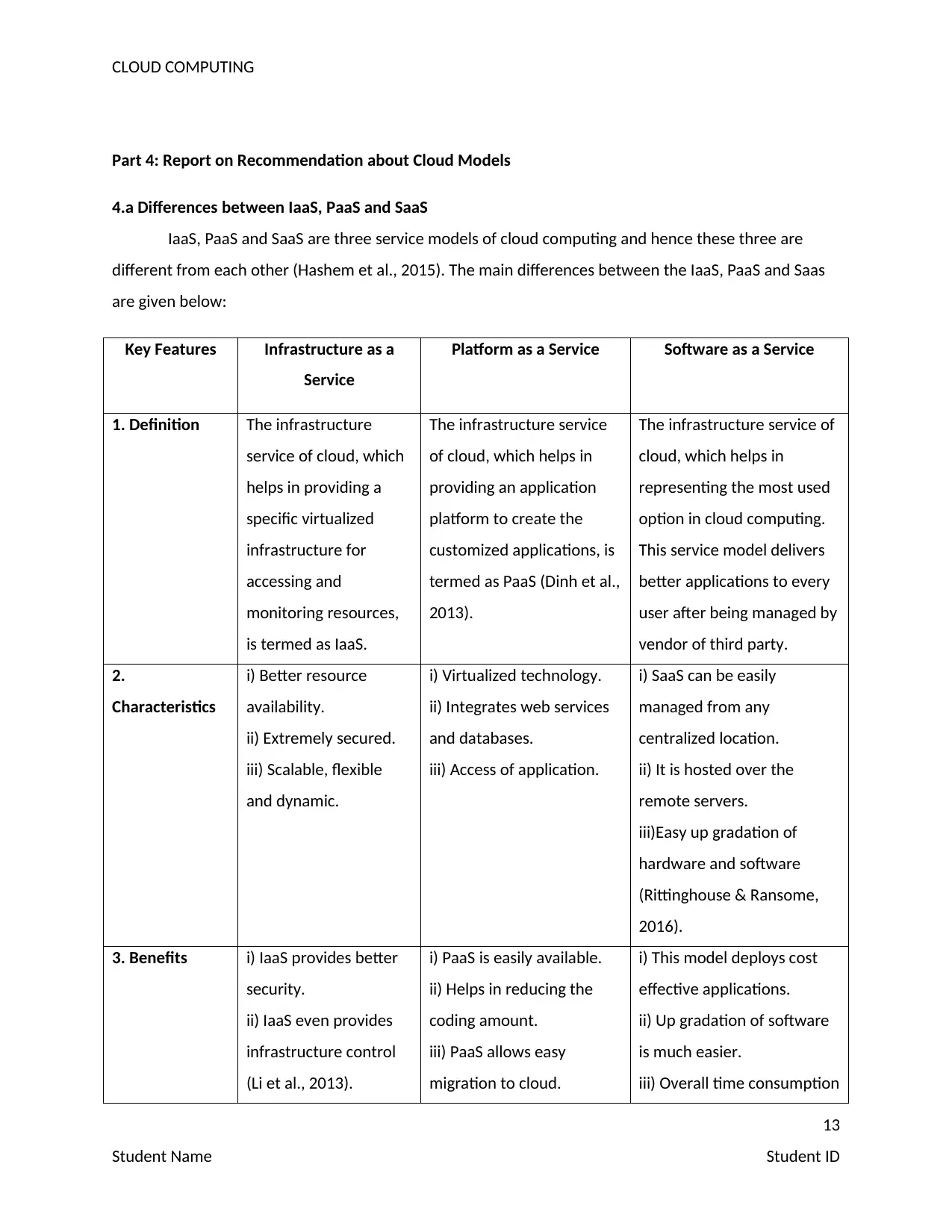
CLOUD COMPUTING
Part 4: Report on Recommendation about Cloud Models
4.a Differences between IaaS, PaaS and SaaS
IaaS, PaaS and SaaS are three service models of cloud computing and hence these three are
different from each other (Hashem et al., 2015). The main differences between the IaaS, PaaS and Saas
are given below:
Key Features Infrastructure as a
Service
Platform as a Service Software as a Service
1. Definition The infrastructure
service of cloud, which
helps in providing a
specific virtualized
infrastructure for
accessing and
monitoring resources,
is termed as IaaS.
The infrastructure service
of cloud, which helps in
providing an application
platform to create the
customized applications, is
termed as PaaS (Dinh et al.,
2013).
The infrastructure service of
cloud, which helps in
representing the most used
option in cloud computing.
This service model delivers
better applications to every
user after being managed by
vendor of third party.
2.
Characteristics
i) Better resource
availability.
ii) Extremely secured.
iii) Scalable, flexible
and dynamic.
i) Virtualized technology.
ii) Integrates web services
and databases.
iii) Access of application.
i) SaaS can be easily
managed from any
centralized location.
ii) It is hosted over the
remote servers.
iii)Easy up gradation of
hardware and software
(Rittinghouse & Ransome,
2016).
3. Benefits i) IaaS provides better
security.
ii) IaaS even provides
infrastructure control
(Li et al., 2013).
i) PaaS is easily available.
ii) Helps in reducing the
coding amount.
iii) PaaS allows easy
migration to cloud.
i) This model deploys cost
effective applications.
ii) Up gradation of software
is much easier.
iii) Overall time consumption
13
Student Name Student ID
Part 4: Report on Recommendation about Cloud Models
4.a Differences between IaaS, PaaS and SaaS
IaaS, PaaS and SaaS are three service models of cloud computing and hence these three are
different from each other (Hashem et al., 2015). The main differences between the IaaS, PaaS and Saas
are given below:
Key Features Infrastructure as a
Service
Platform as a Service Software as a Service
1. Definition The infrastructure
service of cloud, which
helps in providing a
specific virtualized
infrastructure for
accessing and
monitoring resources,
is termed as IaaS.
The infrastructure service
of cloud, which helps in
providing an application
platform to create the
customized applications, is
termed as PaaS (Dinh et al.,
2013).
The infrastructure service of
cloud, which helps in
representing the most used
option in cloud computing.
This service model delivers
better applications to every
user after being managed by
vendor of third party.
2.
Characteristics
i) Better resource
availability.
ii) Extremely secured.
iii) Scalable, flexible
and dynamic.
i) Virtualized technology.
ii) Integrates web services
and databases.
iii) Access of application.
i) SaaS can be easily
managed from any
centralized location.
ii) It is hosted over the
remote servers.
iii)Easy up gradation of
hardware and software
(Rittinghouse & Ransome,
2016).
3. Benefits i) IaaS provides better
security.
ii) IaaS even provides
infrastructure control
(Li et al., 2013).
i) PaaS is easily available.
ii) Helps in reducing the
coding amount.
iii) PaaS allows easy
migration to cloud.
i) This model deploys cost
effective applications.
ii) Up gradation of software
is much easier.
iii) Overall time consumption
13
Student Name Student ID

CLOUD COMPUTING
iii) The third advantage
is its super flexibility.
is reduced.
4. Examples Amazon Web Services,
Rackspace and
Microsoft Azure.
Windows Azure, Apache
Stratos and Google App
Engine.
Cisco WebEx, Google Apps
and Salesforce.
4.b Recommendation for Appropriate Model for SharePoint Service
The recommended or the suggested model for the organization of MetaSoft Ltd is IaaS or
infrastructure as a service. This is considered as one of the most efficient and effective model to shift to
the service of SharePoint (Garg, Versteeg & Buyya, 2013). SharePoint 2010 is the particular collaborative
web based platform that is used in integrating with Microsoft Office software. This can be configured
easily and the utilization of the platform is done within several companies.
There are various significant benefits of the infrastructure as a service. Following are the few
benefits of this particular cloud service model.
i) High Security: The most important advantage of this cloud model is that it is extremely
secured (Hashizume et al., 2013). Due to the high security, the overall data can be easily operated
within the model and the data is not at all lost.
ii) High Speed: The total speed of the IaaS service model is extremely high.
iii) Better Flexibility: The next benefit of the service model of IaaS is that it is extremely flexible
and thus SharePoint 2010 can be easily shifted.
14
Student Name Student ID
iii) The third advantage
is its super flexibility.
is reduced.
4. Examples Amazon Web Services,
Rackspace and
Microsoft Azure.
Windows Azure, Apache
Stratos and Google App
Engine.
Cisco WebEx, Google Apps
and Salesforce.
4.b Recommendation for Appropriate Model for SharePoint Service
The recommended or the suggested model for the organization of MetaSoft Ltd is IaaS or
infrastructure as a service. This is considered as one of the most efficient and effective model to shift to
the service of SharePoint (Garg, Versteeg & Buyya, 2013). SharePoint 2010 is the particular collaborative
web based platform that is used in integrating with Microsoft Office software. This can be configured
easily and the utilization of the platform is done within several companies.
There are various significant benefits of the infrastructure as a service. Following are the few
benefits of this particular cloud service model.
i) High Security: The most important advantage of this cloud model is that it is extremely
secured (Hashizume et al., 2013). Due to the high security, the overall data can be easily operated
within the model and the data is not at all lost.
ii) High Speed: The total speed of the IaaS service model is extremely high.
iii) Better Flexibility: The next benefit of the service model of IaaS is that it is extremely flexible
and thus SharePoint 2010 can be easily shifted.
14
Student Name Student ID

CLOUD COMPUTING
Figure 1: Advantages of IaaS
(Source: Dinh et al., 2013)
4.c Problems and Solutions of the Recommended Model
However, there are few problems with this recommended model. The main problems of IaaS are
given below:
i) Higher Implementation Costs: The total implementation costs of IaaS service model is
extremely high and thus MetaSoft Ltd. can face major issues due to this.
This particular issue can be easily resolved with the help of minimization of customization
(Krishna, 2013).
ii) Zero Control on Servers: The second significant issue of the service model of infrastructure as
a service is that there is absolutely no control on the servers.
This particular issue can be easily resolved with the help of SSL certificates.
15
Student Name Student ID
Figure 1: Advantages of IaaS
(Source: Dinh et al., 2013)
4.c Problems and Solutions of the Recommended Model
However, there are few problems with this recommended model. The main problems of IaaS are
given below:
i) Higher Implementation Costs: The total implementation costs of IaaS service model is
extremely high and thus MetaSoft Ltd. can face major issues due to this.
This particular issue can be easily resolved with the help of minimization of customization
(Krishna, 2013).
ii) Zero Control on Servers: The second significant issue of the service model of infrastructure as
a service is that there is absolutely no control on the servers.
This particular issue can be easily resolved with the help of SSL certificates.
15
Student Name Student ID
Secure Best Marks with AI Grader
Need help grading? Try our AI Grader for instant feedback on your assignments.
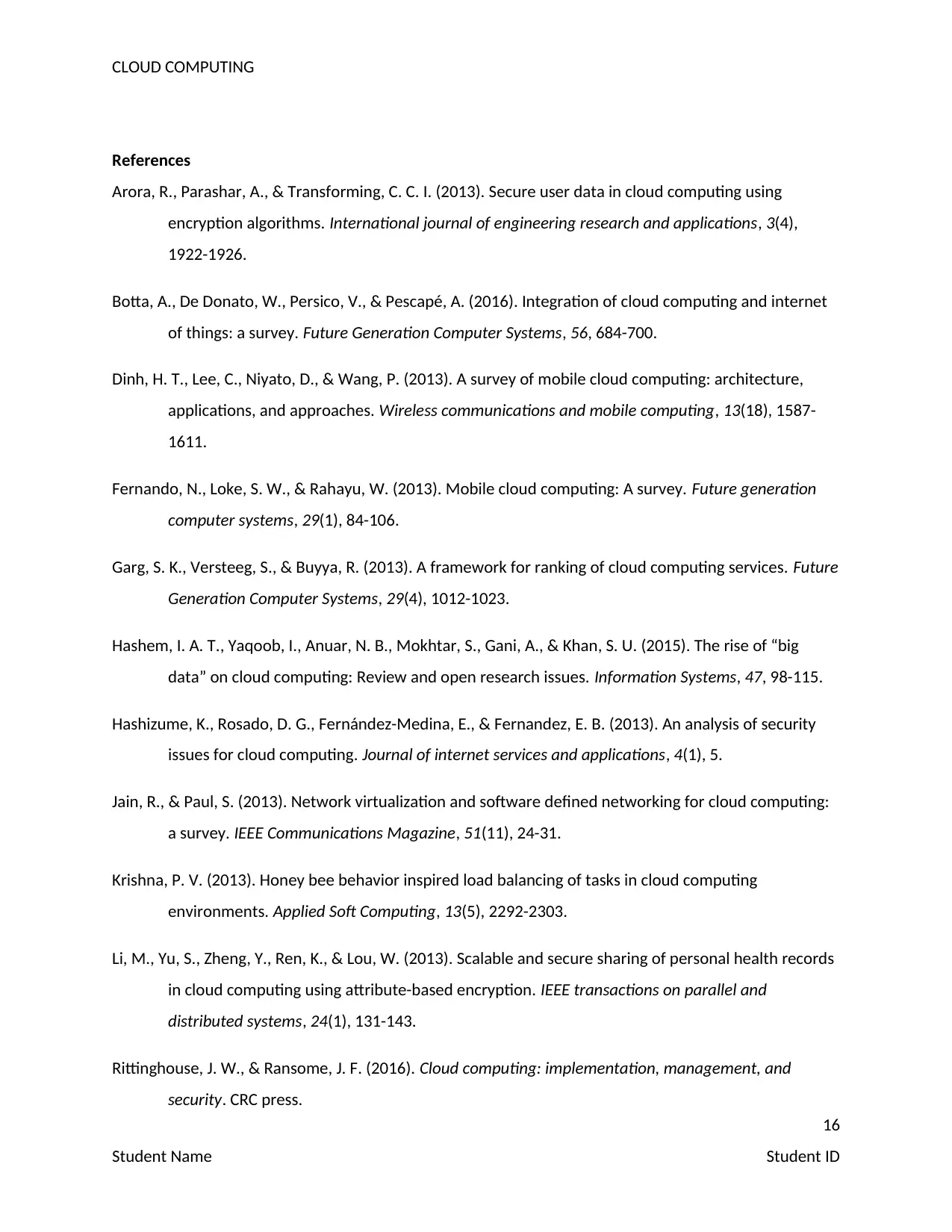
CLOUD COMPUTING
References
Arora, R., Parashar, A., & Transforming, C. C. I. (2013). Secure user data in cloud computing using
encryption algorithms. International journal of engineering research and applications, 3(4),
1922-1926.
Botta, A., De Donato, W., Persico, V., & Pescapé, A. (2016). Integration of cloud computing and internet
of things: a survey. Future Generation Computer Systems, 56, 684-700.
Dinh, H. T., Lee, C., Niyato, D., & Wang, P. (2013). A survey of mobile cloud computing: architecture,
applications, and approaches. Wireless communications and mobile computing, 13(18), 1587-
1611.
Fernando, N., Loke, S. W., & Rahayu, W. (2013). Mobile cloud computing: A survey. Future generation
computer systems, 29(1), 84-106.
Garg, S. K., Versteeg, S., & Buyya, R. (2013). A framework for ranking of cloud computing services. Future
Generation Computer Systems, 29(4), 1012-1023.
Hashem, I. A. T., Yaqoob, I., Anuar, N. B., Mokhtar, S., Gani, A., & Khan, S. U. (2015). The rise of “big
data” on cloud computing: Review and open research issues. Information Systems, 47, 98-115.
Hashizume, K., Rosado, D. G., Fernández-Medina, E., & Fernandez, E. B. (2013). An analysis of security
issues for cloud computing. Journal of internet services and applications, 4(1), 5.
Jain, R., & Paul, S. (2013). Network virtualization and software defined networking for cloud computing:
a survey. IEEE Communications Magazine, 51(11), 24-31.
Krishna, P. V. (2013). Honey bee behavior inspired load balancing of tasks in cloud computing
environments. Applied Soft Computing, 13(5), 2292-2303.
Li, M., Yu, S., Zheng, Y., Ren, K., & Lou, W. (2013). Scalable and secure sharing of personal health records
in cloud computing using attribute-based encryption. IEEE transactions on parallel and
distributed systems, 24(1), 131-143.
Rittinghouse, J. W., & Ransome, J. F. (2016). Cloud computing: implementation, management, and
security. CRC press.
16
Student Name Student ID
References
Arora, R., Parashar, A., & Transforming, C. C. I. (2013). Secure user data in cloud computing using
encryption algorithms. International journal of engineering research and applications, 3(4),
1922-1926.
Botta, A., De Donato, W., Persico, V., & Pescapé, A. (2016). Integration of cloud computing and internet
of things: a survey. Future Generation Computer Systems, 56, 684-700.
Dinh, H. T., Lee, C., Niyato, D., & Wang, P. (2013). A survey of mobile cloud computing: architecture,
applications, and approaches. Wireless communications and mobile computing, 13(18), 1587-
1611.
Fernando, N., Loke, S. W., & Rahayu, W. (2013). Mobile cloud computing: A survey. Future generation
computer systems, 29(1), 84-106.
Garg, S. K., Versteeg, S., & Buyya, R. (2013). A framework for ranking of cloud computing services. Future
Generation Computer Systems, 29(4), 1012-1023.
Hashem, I. A. T., Yaqoob, I., Anuar, N. B., Mokhtar, S., Gani, A., & Khan, S. U. (2015). The rise of “big
data” on cloud computing: Review and open research issues. Information Systems, 47, 98-115.
Hashizume, K., Rosado, D. G., Fernández-Medina, E., & Fernandez, E. B. (2013). An analysis of security
issues for cloud computing. Journal of internet services and applications, 4(1), 5.
Jain, R., & Paul, S. (2013). Network virtualization and software defined networking for cloud computing:
a survey. IEEE Communications Magazine, 51(11), 24-31.
Krishna, P. V. (2013). Honey bee behavior inspired load balancing of tasks in cloud computing
environments. Applied Soft Computing, 13(5), 2292-2303.
Li, M., Yu, S., Zheng, Y., Ren, K., & Lou, W. (2013). Scalable and secure sharing of personal health records
in cloud computing using attribute-based encryption. IEEE transactions on parallel and
distributed systems, 24(1), 131-143.
Rittinghouse, J. W., & Ransome, J. F. (2016). Cloud computing: implementation, management, and
security. CRC press.
16
Student Name Student ID
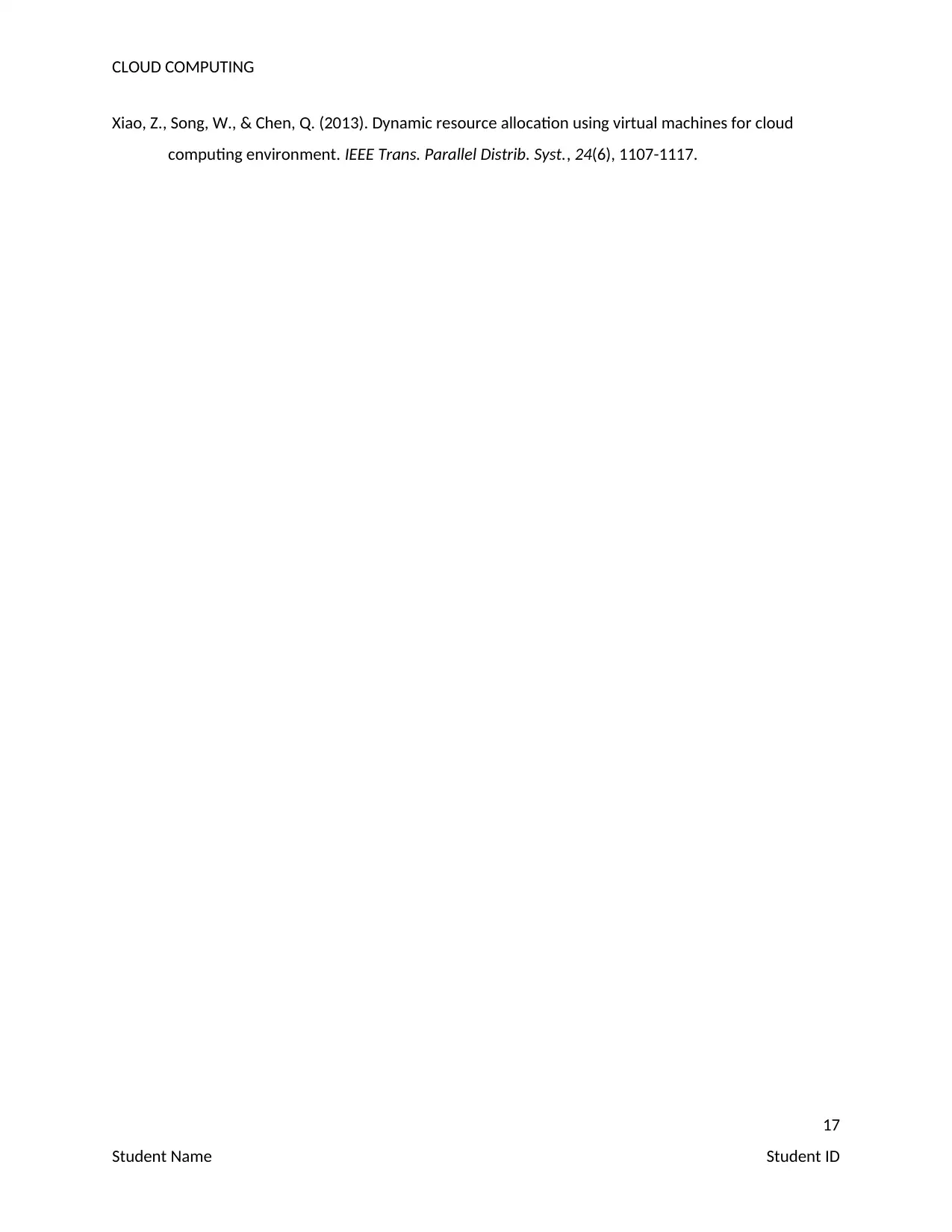
CLOUD COMPUTING
Xiao, Z., Song, W., & Chen, Q. (2013). Dynamic resource allocation using virtual machines for cloud
computing environment. IEEE Trans. Parallel Distrib. Syst., 24(6), 1107-1117.
17
Student Name Student ID
Xiao, Z., Song, W., & Chen, Q. (2013). Dynamic resource allocation using virtual machines for cloud
computing environment. IEEE Trans. Parallel Distrib. Syst., 24(6), 1107-1117.
17
Student Name Student ID
1 out of 18
Related Documents
Your All-in-One AI-Powered Toolkit for Academic Success.
+13062052269
info@desklib.com
Available 24*7 on WhatsApp / Email
![[object Object]](/_next/static/media/star-bottom.7253800d.svg)
Unlock your academic potential
© 2024 | Zucol Services PVT LTD | All rights reserved.




